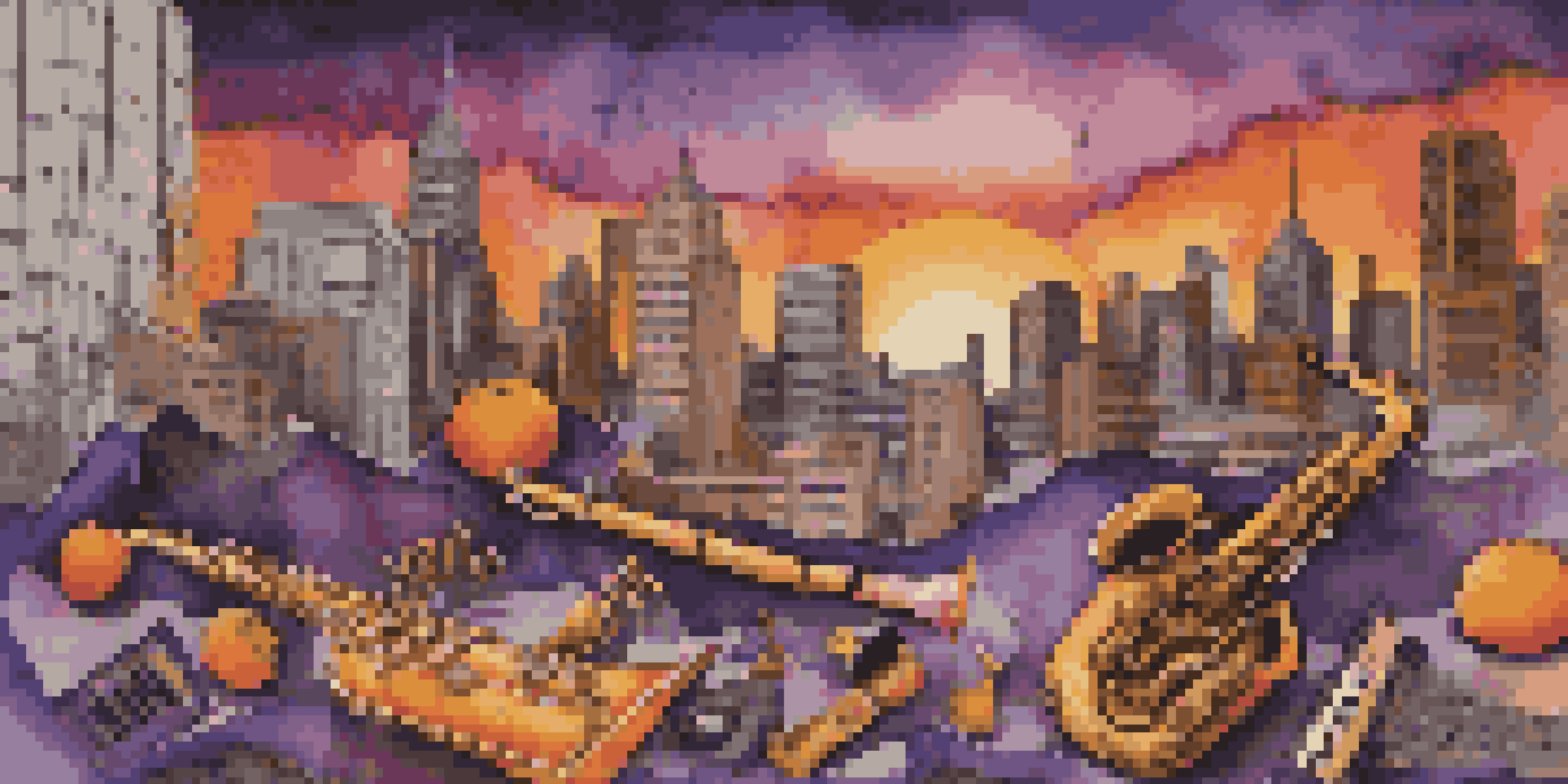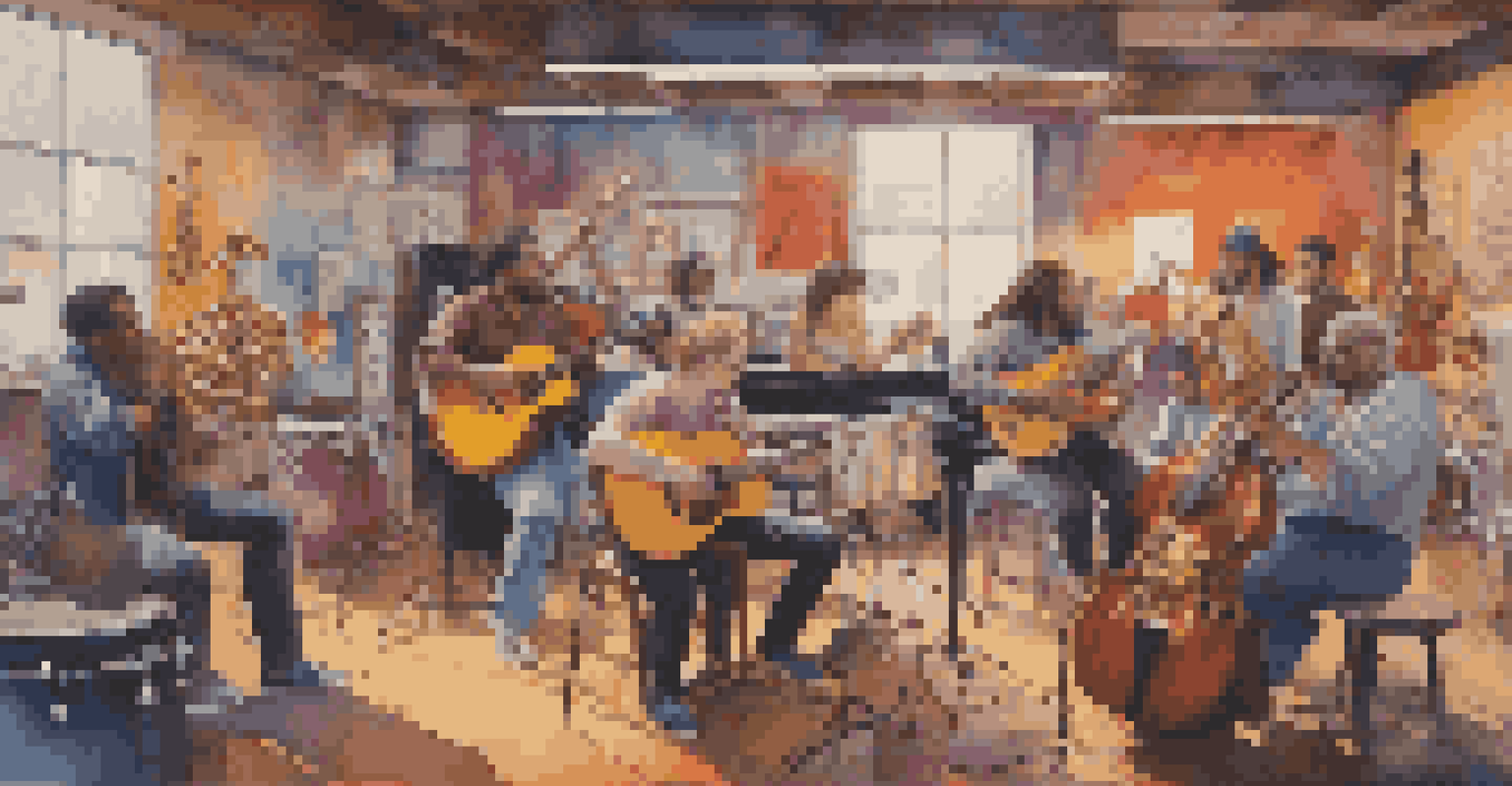The Role of Lyrics in Genre-Blending Music Styles

Defining Genre-Blending Music and Its Significance
Genre-blending music combines elements from various musical styles, creating a rich tapestry of sound. This fusion allows artists to experiment and push creative boundaries, often leading to captivating and innovative tracks. For instance, think of a song that marries hip-hop with jazz, instantly adding depth and texture through contrasting rhythms and melodies.
Music is the universal language of mankind.
The significance of genre-blending lies in its ability to reach diverse audiences. When musicians draw from multiple influences, they create something unique that resonates with listeners from different backgrounds. This cross-pollination of genres not only enhances the listening experience but also promotes cultural exchange, making music more inclusive.
As artists embrace this fluidity, lyrics play a crucial role in bridging the gap between genres. They can reflect the ethos of the music while also telling stories that engage listeners, making them an essential component of any genre-blending piece.
The Role of Lyrics in Expressing Cultural Identity
Lyrics often serve as a canvas for artists to paint their cultural identity, offering insight into their backgrounds and experiences. In genre-blending music, these narratives can draw from multiple heritages, creating a richer story that resonates with a wider audience. For example, a song that incorporates both reggae beats and hip-hop lyrics might reflect the artist's Caribbean roots while also embracing urban culture.

When artists blend genres, their lyrics can challenge stereotypes and broaden perspectives. By weaving different cultural influences into their songs, they invite listeners to appreciate the complexity of their identities. This blend not only enhances authenticity but also fosters a deeper connection with fans who may share similar experiences.
Furthermore, these culturally rich lyrics can act as a bridge between communities, encouraging dialogue and understanding. As listeners engage with these narratives, they gain a greater appreciation for the diverse backgrounds that shape the music they love.
How Lyrics Enhance Emotional Resonance in Music
Lyrics have a unique power to evoke emotions, making them central to the listener's experience. In genre-blending music, the combination of different styles can amplify this emotional impact. For instance, a heartfelt ballad infused with upbeat pop elements can create a juxtaposition that captures the complexity of joy and sorrow.
The beauty of music is that it connects people, transcending language and cultural barriers.
When artists blend genres, the lyrical themes can range from personal struggles to social commentary, providing layers of meaning. This emotional depth invites listeners to reflect on their own feelings and experiences, fostering a sense of connection. A powerful lyric can transform a catchy tune into an anthem that resonates on a deeper level.
Moreover, the emotional resonance of lyrics can be heightened through the interplay of different musical styles. The contrast between a soft acoustic guitar and a driving electronic beat, paired with poignant lyrics, can create a dynamic listening experience that lingers long after the song ends.
The Influence of Collaboration on Lyrical Creativity
Collaboration is a hallmark of genre-blending music, often leading to innovative lyrical ideas. When artists from different musical backgrounds come together, they bring unique perspectives that can enrich the songwriting process. For example, a country musician collaborating with a hip-hop artist may result in lyrics that blend storytelling with rhythmic wordplay, creating something entirely new.
This collaborative spirit not only fosters creativity but also encourages artists to step outside their comfort zones. By combining their strengths, they can produce lyrics that resonate with a broader audience while still maintaining their individual voices. The result is often a richer, more textured lyrical landscape that reflects the fusion of genres.
Additionally, these collaborations can introduce listeners to new lyrical themes and styles. As different artists share their experiences and influences, they expand the narrative possibilities of genre-blending music, creating a vibrant tapestry of stories that captivates audiences.
Exploring Storytelling Through Genre Fusion
Storytelling is a fundamental aspect of music, and in genre-blending styles, it takes on new dimensions. Lyrics can weave intricate narratives that reflect the diverse influences of the music, allowing artists to explore various themes and emotions. For example, a song that combines folk melodies with hip-hop beats might tell a story of resilience, drawing from both rural and urban experiences.
In this way, genre-blending allows for a broader range of storytelling techniques. Artists can experiment with different lyrical forms, from traditional verses to spoken word, ultimately enhancing the narrative depth. This flexibility encourages creativity and invites listeners to engage with the story on multiple levels.
Moreover, the juxtaposition of genres can mirror the complexities of real-life experiences. Just as life often blends various influences and cultures, genre-blending music reflects this reality through its lyrics, creating relatable and authentic narratives that resonate with listeners.
The Impact of Lyrics on Audience Engagement
In genre-blending music, engaging lyrics can significantly enhance audience connection. When listeners relate to the lyrics, they become invested in the song, creating a sense of community around shared experiences. For instance, an upbeat track that tackles themes of empowerment can uplift listeners, making them feel part of a larger movement.
Furthermore, lyrics can spark conversations and discussions, encouraging fans to share their interpretations and personal connections. This interaction not only fosters a deeper appreciation for the music but also strengthens the bond between artists and their audience. A song that resonates can become a rallying cry, inspiring fans to unite around common themes.
Ultimately, the power of lyrics in genre-blending music lies in their ability to bridge divides and foster connection. By resonating with diverse audiences, these lyrics can turn a simple song into an anthem that transcends cultural boundaries.
The Future of Lyrics in Evolving Music Landscapes
As music continues to evolve, the role of lyrics in genre-blending styles will likely expand. With technological advancements and the rise of digital platforms, artists have more opportunities than ever to collaborate and experiment with their songwriting. This evolution will enable them to reach wider audiences and explore new lyrical themes that reflect contemporary issues.
Moreover, as global influences shape music, we can expect to see an even greater fusion of languages and cultures in lyrics. Artists may draw from their native tongues while blending them with other languages, creating a rich tapestry of sounds and meanings. This trend not only enhances the listening experience but also promotes linguistic diversity in music.

In this dynamic landscape, the importance of lyrics will remain central to the storytelling aspect of genre-blending music. As artists continue to innovate, we can anticipate a future where lyrics not only reflect cultural narratives but also become a powerful tool for social change and unity.